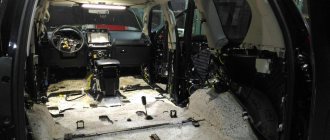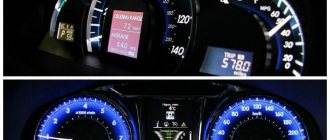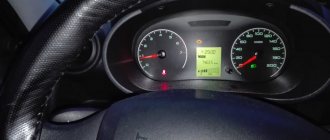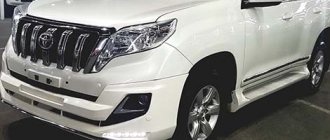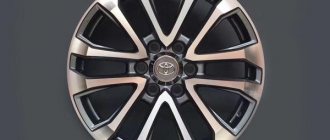Toyota Land Cruiser Prado 150 is a medium-sized SUV, which has been produced for 4 generations to date. In this article we will show a description of fuses and relays for the Toyota Land Cruiser Prado 150 with block diagrams and their locations for cars produced in 2009, 2010, 2011, 2012, 2013, 2014, 2015, 2021, 2021, 2021, 2021, 2021, 2021 year.
This model has been restyled several times, so the purpose of the elements in the blocks may differ from what is presented. Check the purpose of the elements with your diagrams on the block cover.
What data is shown on the display
Description of the icons appearing on the dashboard of the Prado 150:
- Air intake from outside if the corresponding key is pressed. If the indicator is not lit, it means that the fence is not being collected from outside.
- Rear and front window heating indicators. If these indicators are not lit, then the windows are not heated. This mode, which is turned on in autumn and spring, does not allow the windows to fog up as a result of temperature changes outside and inside.
- Heated windshield wiper blades. This light turns off automatically.
- Turning the heater power on and off is also displayed on the vehicle's heater monitor. It is recommended to turn on the key corresponding to increasing engine power to increase temperature only when the vehicle is stationary.
- The light with the inscription A/C may light up when the key of the same name is pressed. The indicator shows that the vehicle has a cooling and dehumidification function.
At low temperatures, this mode may not turn on.
The buttons in the Prado 150's interior also matter. For example, on the temperature control panel inside the vehicle.
The air vents on all models can also be adjusted via a mechanism located on the instrument panel. They direct the flow towards or away from the glass, thereby regulating the process of removing dew drops from the windows.
Air conditioning is carried out by engine speed during eco-friendly driving. To improve this process, it is recommended to disable the fuel saver feature.
Block in the cabin
The main fuse box in the cabin is located under the instrument panel.
Photo example of execution
Scheme from the block cover
Scheme
Description
| 1 | 15A P/OUTLET - Electrical outlet |
| 2 | 7.5A ACC - Outside rear view mirror motor. BODY ECU, Air Conditioning System, Audio System, Navigation System, Parking Assist, Sequential Switch, Backup Repair, DSS#2 ECU, AT Indicator EFI ECU, Shift Lock ECU |
| 3 | 10A BKUP LP - Reversing lights, audio system, multifunction display, DSS#2 ECU, parking assist sensor |
| 4 | 10A TOWING BKLP - Towing |
| 5 | 20A AVS - Air Suspension System |
| 6 | 10A KDSS ECU |
| 7 | 20A 4WD - 4WD system. rear differential lock |
| 8 | 30A P/SEAT FL - Power front seat (left) |
| 9 | 25A - Door lock motor, sunroof opener, BODY ECU |
| 10 | 30A PSB ECU |
| 11 | 15A TI & TE - Steering wheel tilt and reach adjustment |
| 12 | 15A FOG FR - Fog lights |
| 13 | 7.5A OBD - Diagnostic connector |
| 14 | 7.5A A/C - Air conditioning system |
| 15 | 7.5A AM1 - Starting system |
| 16 | 25A DOOR RL — Power windows rear window (left) |
| 17 | 10A ECU-IG NO.1 - Shift Lock ECU, VSC ECU, Steering Sensor, Yaw Rate Sensor, Sequential Switch, Auto Wiper ECU, Backup Relay, Heated Outside Rear View Mirror, Tilt and Length Steering Column, PSB ECU , DSS#1 ECU, front radar sensor, power steering ECU, AFS ECU |
| 18 | 7.5A IG1 - Front turn signal, rear turn signal, side turn signal, turn signal, trailer light, ALT, VSC, C/C switch |
| 19 | 10A ECU-IG NO.2 - Rear Window Defogger, Heated Seat Switch, Inverter Relay, Air Conditioning System, EU Mirror, BODY ECU, Auxiliary Heater Switch, Navigation System, DSS#2 ECU, Sunroof ECU, Instrument Switch, Assistance System Sensor when parking, auxiliary instruments, folding seat ECU, O/H IG, anti-ice device, AFS ECU, D-module, rain sensor, air suspension P/SEAT IND |
| 20 | 20A S/HTR FR - Seat heater |
| 21 | 30A P/SEAT FR - Power front seat (right) |
| 22 | 30A DOOR P - Electric power window of the front window (passenger side) |
| 23 | 10A DOOR — Power windows |
| 24 | 25A DOOR D — Electric front window (driver's side) |
| 25 | 25A DOOR RR - Rear window power windows (right) |
| 26 | 25A S/ROOF - Sunroof |
| 27 | 30A WIP - Windshield wipers and washer |
| 28 | 20A WASHER - Windshield wipers and washer, rear window wipers and washer |
| 29 | 10A COOLING - Cooled compartment |
| 30 | 10A IGN - EFI ECU, C/OPN RLV, VSC ECU, Airbag ECU, Intelligent Entry and Start System, Steering Lock ECU. Gateway ECU CAN |
| 31 | 7.5A GAUGE - Gauges |
| 32 | 7.5A PANEL - Switch illumination, glove box illumination, navigation system, audio system, air conditioning system, outside rear view mirror switch, seat folding switch, multifunction display. P/SEAT IND, SHIFT, COOL BOX |
| 33 | 10A TAIL - Front marker lights, tail lights, license plate lights, EFI ECU, rear fog lights, towing, front fog lights |
Fuse number 1 at 15A is responsible for the cigarette lighter.
Some relays, for example a turn signal relay, can be attached next to these blocks.
Toyota Land Cruiser Prado 150: any problems?
“We are considering purchasing a Toyota Land Cruiser Prado 150 with a diesel engine, 2010-2013. What kind of all-wheel drive schemes do they have (I heard that in Arabic versions it is plug-in)? What configurations? What should you pay attention to when buying this model?
Great choice! True, we strongly do not recommend buying a TLC150 just because “it’s a Toyota”, and based on rumors that “You can’t kill a Land Cruiser” - a careless owner can turn any car into trash in a few years. And it wouldn’t hurt to thoroughly evaluate the driving performance in all modes before purchasing: a frame car with a rear axle (even on air) drives completely differently than crossovers with a rear “multi-link.”
However, if you are completely satisfied with the driving performance, design and ergonomics of the driver's seat in the TLC 150, then we hasten to congratulate you - you have made the right choice. All experts unanimously say: Prado is the most reliable in its class, there are an order of magnitude fewer problems with it than with Mitsubishi Pajero 3-4 or Nissan Pathfinder. Under comparable, of course, mileage and operating conditions, because if the Pathfinder is mainly bought by city dwellers, then the 150th Prado is often driven off the asphalt.
As for the types of drive, the 150 in particular was equipped only with permanent all-wheel drive with an asymmetrical Torsen center differential. Versions with “part time” are unknown to a wide range of fans; this type of drive can only be found on a very exotic version for the Arabic or some other atypical market for us. At least in all reference books and encyclopedias it is indicated that the Prado 150 is available only with a permanent all-wheel drive system with a torque distribution of 40/60 in favor of the rear axle (in a static state) and with the possibility of its “circulation” in a ratio of 28:72 to 58:42%. In addition, at speeds up to 100 km/h the differential can be forcibly locked. Rear differential - limited slip (LSD), as an option - with forced hard locking.
Later, to help the all-wheel drive, the Multi-Terrain System also appeared - essentially a regular traction control system, but with several operating modes: stones, gravel, snow, mud. Off-road professionals consider such “helpers” superfluous, especially in the presence of full-fledged locks, but for a beginner they can be useful - if you don’t know how, you can break the lock and bury the car out of the blue.
Well, now we can move on to reliability. Since the 150 was created on the basis of the predecessor Prado 120, most of the solutions and components have already been tested by time and long runs. The frame was made even more torsionally strong, and the 4-liter gasoline engine was equipped with a Dual-VVT-i system, thanks to which its power increased to 282 hp. By the way, this engine is considered very reliable and unpretentious, so if you can’t find a turbodiesel version in good condition, we recommend taking a closer look.
There was only one diesel engine in the production years you indicated - a three-liter 1KD-FTV with a power of 173 hp. The engine is excellent, dating back to the 1990s, but in accordance with the trends of the times, it is equipped with more advanced Common Rail fuel equipment and a particulate filter. Naturally, with significant mileage, all this may require attention due to the quality of our fuel. But this engine does not have any characteristic problems (unlike the Pajero 3.2 DiD).
The Prado 150 itself has a few of them, which is confirmed by the almost unrealistic prices on the secondary market. This, by the way, is very fraught: the chances of running into a “double” are very high, especially if the car was imported from Russia. But even if it was bought new here and never traveled anywhere, this does not at all guarantee the absence of criminal problems.
But the car itself rarely bothers the owner, even over small things. From the little that can be remembered, the only “weaknesses” can be called wheel bearings and souring calipers. If you have a rich package, the suspension with KDSS can indulge in some “pranks” - it starts to rattle even at low mileage. By the way, many Prado 150 were equipped with rear air suspension - there is an opinion among ordinary people that it allows increasing ground clearance. In fact, since there is an “axle” at the rear, the clearance always remains constant (about 220 mm on standard wheels). When inflating the rear air springs, only the so-called “ramp angle” changes, that is, if the car sits on its belly on a roll, raising the suspension can help; if it sits simply in a rut, you cannot increase the ground clearance. Therefore, the main advantage of the pneuma is a smoother ride on uneven surfaces.
Well, the competitive advantages of the Land Cruiser Prado 150 itself are a high degree of “survivability”, the almost complete absence of minor problems, including with numerous electrical systems, and the overall thoughtfulness of the design. And although, due to its complexity, mechanics praise the 120th more, it is already impossible to find it in good condition and with low mileage, but the 150th is quite possible, especially since quite a lot of them were sold here new. This means you can trace the entire history of the car, which is very important. But as for corrosion, you shouldn’t forget about it: the body seems to be strong, but behind the frame you need an eye and an eye, so additional anti-corrosion is recommended. Especially the “Arabic” versions, which, among other things, are also distinguished by very mediocre sound insulation.
Price Pulse
In our database of free advertisements on ABW.BY there are more than 40 copies of the Toyota Land Cruiser Prado 150 for sale. Prices start from $23,191.
Pavel KOZLOVSKY Photo from open sources ABW.BY
You have questions? We have the answers. Topics that interest you will be expertly commented on by either specialists or our authors - you will see the results on the website abw.by. Send questions to [email protected] and follow the site
Original used spare parts for Toyota Land Cruiser Prad o with photographs and the price of each part on the BAMPER.BY website.
Heating and air conditioning control
No car can do without an air conditioner and interior heater. These are important components of the car, thanks to which the driver and passengers can feel comfortable in the cabin. It is important for the driver to know how the operation of the air conditioner and heater is controlled from the control panel (see the corresponding assembly drawings “Air conditioner and heater control panel”).
Heater and air conditioner control keys
1. (Models with automatic control of air conditioning and heating) To turn on the air conditioning or heater, press the “AUTO” switch (5). To turn on the air conditioner, press the “A/C” switch (1). When the air conditioner is turned on, the indicator on the switch lights up. If the air conditioning mode was turned on before the last shutdown, then when turned on, the air conditioning mode will immediately begin to operate.
Video on the topic. What's the difference between climate control and air conditioning?
Attention : flashing of the indicator during operation of the air conditioning system indicates a malfunction of the system, and the air conditioner automatically turns off. To turn off the air conditioner, press the “A/C” switch (1) again, in this case the heater will work. If you press the “OFF” switch (4), the heater turns off.
2. (Models with manual control of air conditioning and heater) To turn on the heater, you must move the heater fan rotation speed switch (6) from position “O” to any other. To turn on the air conditioner, press the air conditioner switch “A/C” (1). When the air conditioner is turned on, the indicator on the switch lights up.
Video on the topic. Self-diagnosis of climate control, heating and ventilation in Toyota Camry XV30:
Attention : flashing of the indicator during operation of the air conditioning system indicates a malfunction of the system, and the air conditioner automatically turns off. If the air conditioning mode was turned on before the last shutdown, then when you move the heater fan speed switch (6) from the “O” position, the air conditioning mode will immediately begin to operate. When you press the “A/C” switch (1) again, the air conditioning mode will turn off and the heater will operate. The heater works if the air conditioning mode is turned off.
3. The air flow direction switch (2) is designed to change the direction of airflow. (Models with manual control of air conditioning and heating) To switch the airflow mode, move the switch to the required position.
(Models with automatic control of air conditioning and heater) To switch the blowing mode, press the “MODE” button. An indicator showing the current blowing pattern will appear on the information display. – In this position, the air flow is directed towards the head area.
– In this position, the air flow is directed towards the head and floor at the same time.
– In this position, the air flow is directed almost entirely to the floor; on some models, during heating, warmer air is directed to the floor level, and cooler air is directed to the head area.
– In this position, the air flow is directed to the windshield, front door glass, to the head and floor areas; on some models, a less heated air flow is directed to the head area.
– (Models with manual air conditioning and heating) This position directs the air flow towards the windshield and is used when the windshield fogs up.
3. Air intake adjustment switch (ventilation/recirculation) (3) allows air intake either from outside the vehicle or from the interior.
Note : if the recirculation mode is operated for a long period of time, the windows may fog up.
4. The air flow force is controlled by switch (6).
5. The temperature regulator (7) is used to set the heating or cooling air temperature in the vehicle interior within the range from 18° to 32°C.
(Models with automatic air conditioning and heater control) “MAX COLD” appears on the information display when the maximum cooling mode is set. And “MAX HOT” – maximum heating mode.
Video on the topic. Climate control operation in auto mode:
6. (Models with automatic control of air conditioning and heating) The “AUTO” switch (5) is designed to automatically control the operation of the air conditioning and heating. In the “AUTO” mode, the flow force and direction of the air flow are automatically adjusted. When operating in this mode, it is possible to set the temperature of the incoming air, while the air conditioner/heater will operate in the “AUTO” mode. If you press any other switch, operation in “AUTO” mode will stop.
7. (Models with automatic control of air conditioning and heating) When the windshield fogs up, you must press the windshield defogger switch (8). The windshield defogger is turned off by pressing the switch again. When the blower is turned on, the indicator on the switch lights up.
8. (Models with automatic control of air conditioning and heater) When the switch (3) is pressed, an indication of the ambient air temperature (OUTSIDE TEMP) is shown on the information display. When you press the switch (3) again, the display will return to its original position.
